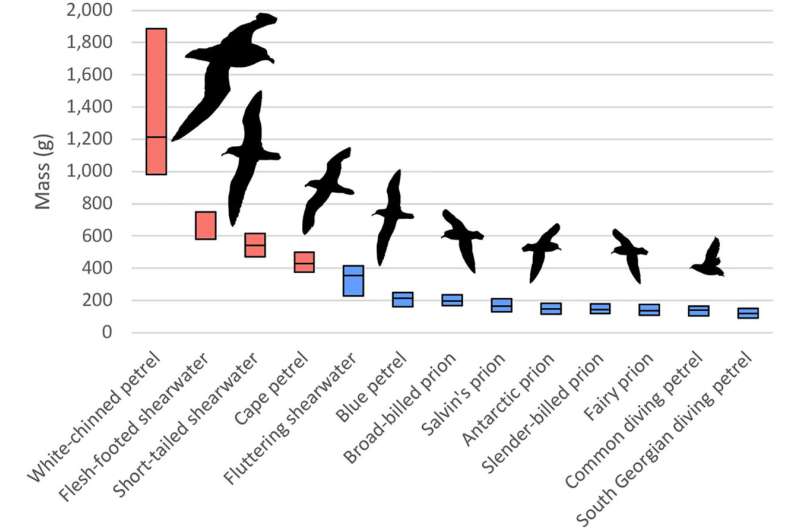Feathers were sampled from seabird species spanning a range of sizes, which were divided into large (≥400 g) and small (<400 g) size categories. The division between large and small was placed at 400 g, where there was a natural division in sizes of petrels sampled. This figure displays the average, upper and lower limits of the mass of the petrels, shearwaters, prions and diving petrels. Masses presented follow the CRC handbook of avian body masses (Dunning, 2007), and Handbook of Australian, New Zealand and Antarctic birds (Marchant & Higgins, 1990) where masses or ranges were not available in Dunning (2007). Albatrosses and giant petrels were all placed in the large size category, with lower limits of mass exceeding 2,000 g, and are not included in this figure. Credit: Global Ecology and Biogeography (2023). DOI: 10.1111/geb.13629
With the largest wingspan of any living bird, the wandering albatross is a giant of the sea. But like several other tube-nosed bird species, it is under threat of extinction.
Now, world first research from CSIRO and the University of South Australia shows that the feathers of seabirds such as the wandering albatross can provide clues about their long-distance foraging, which could help protect these species from further decline.
Comparing 15 element concentrations in the feathers of 253 tube-nosed seabirds of the Southern Hemisphere (representing 15 species), researchers found that the feathers of large seabirds (400g+) such as the wandering albatross (and other highly mobile seabirds) contained nutrients that did not solely match the availability of nutrients in the seawater at the collection site.
Conversely, smaller bird species that foraged more locally had feathers with trace element concentrations that were ten-to-hundred-fold higher than those of larger bird species, clearly representing the ocean basins in which they were feeding.
UniSA's Associate Professor S. "Topa" Petit says feather profiles can help decipher the movements and habitats of open ocean seabirds.
"From the lab work led by Dr. Farzana Kastury, we found that small seabirds' feathers contained substantial amounts of elements that matched their foraging environments, whereas large seabirds, irrespective of which ocean their feathers were collected from, all showed similar trace elements, suggesting they are feeding from a range of different ocean basins," Assoc Prof Petit says
"Small birds that spend a lot of time feeding on planktonic crustaceans in particular areas acquire specific elements from those areas. In contrast, larger birds do not have the same element signature because they forage across multiple ocean basins.
"Our work with feathers may explain why species like the wandering albatross that breed slowly and that are difficult to study because of their open ocean habits travel over such extraordinary distances.
"It points at the significance of micronutrient availability and associated ocean processes in the conservation of seabirds."
Research leader, CSIRO's Dr. Lauren Roman, says understanding factors that affect the distribution of a threatened group of seabirds will help us better protect them in the future.
"It's fascinating to think that highly mobile marine animals may be traveling long distances to meet their mineral needs, in addition to their energy needs," Dr. Roman says.
"But what this also tells us is that we must continue to protect biodiverse marine areas to ensure micronutrient availability for threatened bird species.
"One of the biggest threats to biodiverse marine areas is climate change, as it has the potential to affect nutrient cycles and distribution across the Southern Ocean.
"While more research needs to be done, this work expands our ecological knowledge about oceanic species and the significance of micronutrient availability for the survival of seabirds like the wandering albatross."
The research is published in the journal Global Ecology and Biogeography.
More information: Lauren Roman et al, Nutrients and seabird biogeography: Feather elements differ among oceanic basins in the Southern Hemisphere, reflecting bird size, foraging range and nutrient availability in seawater, Global Ecology and Biogeography (2023). DOI: 10.1111/geb.13629
Journal information: Global Ecology and Biogeography
Provided by CSIRO
























